Embrace Serenity: The Best Wellness Retreats in the Dabie Mountains
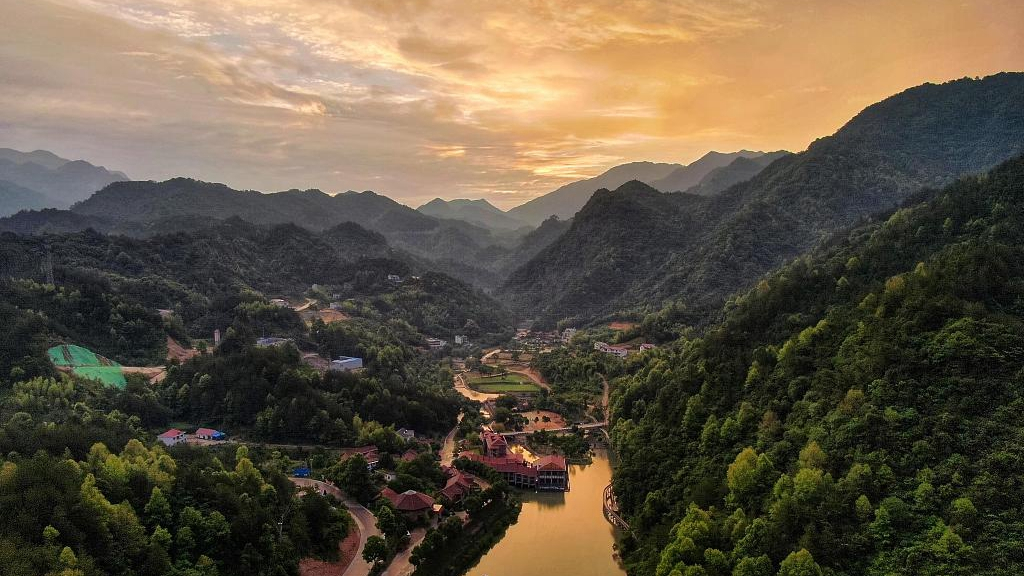
An Essential Guide to Visiting Dabie Mountains
Nestled at the crossroads of three provinces—Anhui, Henan, and Hubei—the Dabie Mountains (大别山) rise majestically, offering a stunning backdrop of natural beauty and rich history. With elevations soaring over 5,000 feet, this enchanting mountain range is not only a haven for outdoor enthusiasts but also a treasure trove of cultural significance. Legend has it that the renowned poet Li Bai once stood atop the clouds here, captivated by the breathtaking vistas that stretched before him. Today, travelers can embark on their own adventures, tracing ancient paths that echo with tales of the Red Army’s revolutionary past and marveling at the diverse flora and fauna that thrive in this unique ecological zone.
As you explore the Dabie Mountains, you’ll encounter the awe-inspiring Baima Peak, the crown jewel of the range, where mystical pines cling to steep cliffs and vibrant wildflowers blanket the hillsides in spring. The region’s charm is further accentuated by its pristine lakes and cascading waterfalls, inviting visitors to immerse themselves in the serene embrace of nature. Whether you’re seeking thrilling hikes, tranquil boat rides on Bieshan Lake, or a glimpse into the historical remnants of Siwang Fortress, the Dabie Mountains promise an unforgettable experience that transcends mere sightseeing. Prepare to be enchanted by this hidden gem of China, where every step unveils a new wonder waiting to be discovered.
In This Guide
- An Essential Guide to Visiting Dabie Mountains
- The Rich History and Legends of Dabie Mountains
- Main Highlights: What You Absolutely Can’t Miss
- Planning Your Visit: A Practical Guide
- Tickets: Prices, Booking, and Tips
- How to Get There: A Complete Transportation Guide
- Local Cuisine and Accommodation Nearby
- Frequently Asked Questions
- Final Thoughts on Your Trip
The Rich History and Legends of Dabie Mountains
Nestled at the confluence of Hubei, Henan, and Anhui provinces, the Dabie Mountains (大别山) are not just a stunning natural wonder but a storied landscape steeped in rich history and captivating legends. This majestic mountain range, with its peaks soaring over 5,000 feet, has long been a source of inspiration and a setting for pivotal events in Chinese history.
The name “Dabie,” which translates to “very different,” was bestowed by the renowned Han Dynasty historian Sima Qian, who noted the striking geographical and ecological contrasts between the north and south slopes of the mountains. This uniqueness is not merely topographical; it encompasses a vibrant tapestry of flora, fauna, and human experiences that have unfolded over millennia.
In ancient times, the Dabie Mountains were revered for their natural beauty and mystical qualities. Legends tell of the great poet Li Bai, who, upon ascending the main peak, Baimajian, marveled at the breathtaking vistas that stretched before him. This connection between the mountains and literary greatness adds an ethereal allure to the landscape, inviting travelers to engage in their own moments of reflection and inspiration.
The mountains also hold significant historical importance, particularly during the tumultuous periods of the 20th century. They served as a strategic base for the Red Army during the Chinese Civil War, with notable military leaders Liu Bocheng and Deng Xiaoping orchestrating key operations from this rugged terrain. The region’s role in shaping the course of modern Chinese history turned the Dabie Mountains into a symbol of resilience and revolutionary spirit.
Among the notable sites within the Dabie Mountains is the Baima Peak, named in homage to a Buddhist dignitary who rode into the region on a white horse during the Eastern Han Dynasty. This peak, often shrouded in clouds, stands as a testament to the intertwining of natural beauty and spiritual significance, attracting both pilgrims and nature enthusiasts alike.
The area is also rich in local folklore. Tales of dragons and spirits inhabit the very essence of the mountains, with Longjing Gorge, known as “The First Gorge of Dabie Mountains,” echoing these legends. Its waterfalls, cascading down with thunderous majesty, are said to be the tears of a dragon mourning for its lost treasure. Such stories not only enhance the cultural landscape of the Dabie Mountains but also deepen the visitor’s experience, as one traverses the paths once walked by both heroes and mythical beings.
In addition to its historical and legendary significance, the Dabie Mountains are a cradle of biodiversity, fostering unique plant species and rare wildlife. This ecological wealth has not gone unnoticed, as the mountains have increasingly become a focal point for conservation efforts, ensuring that both their natural beauty and historical narratives endure for generations to come.
For international travelers, a visit to the Dabie Mountains offers not just an escape into nature but a journey through time—an opportunity to walk in the footsteps of poets, revolutionaries, and legends. As you explore this enchanting region, you will find that the mountains whisper their stories, waiting for those willing to listen.
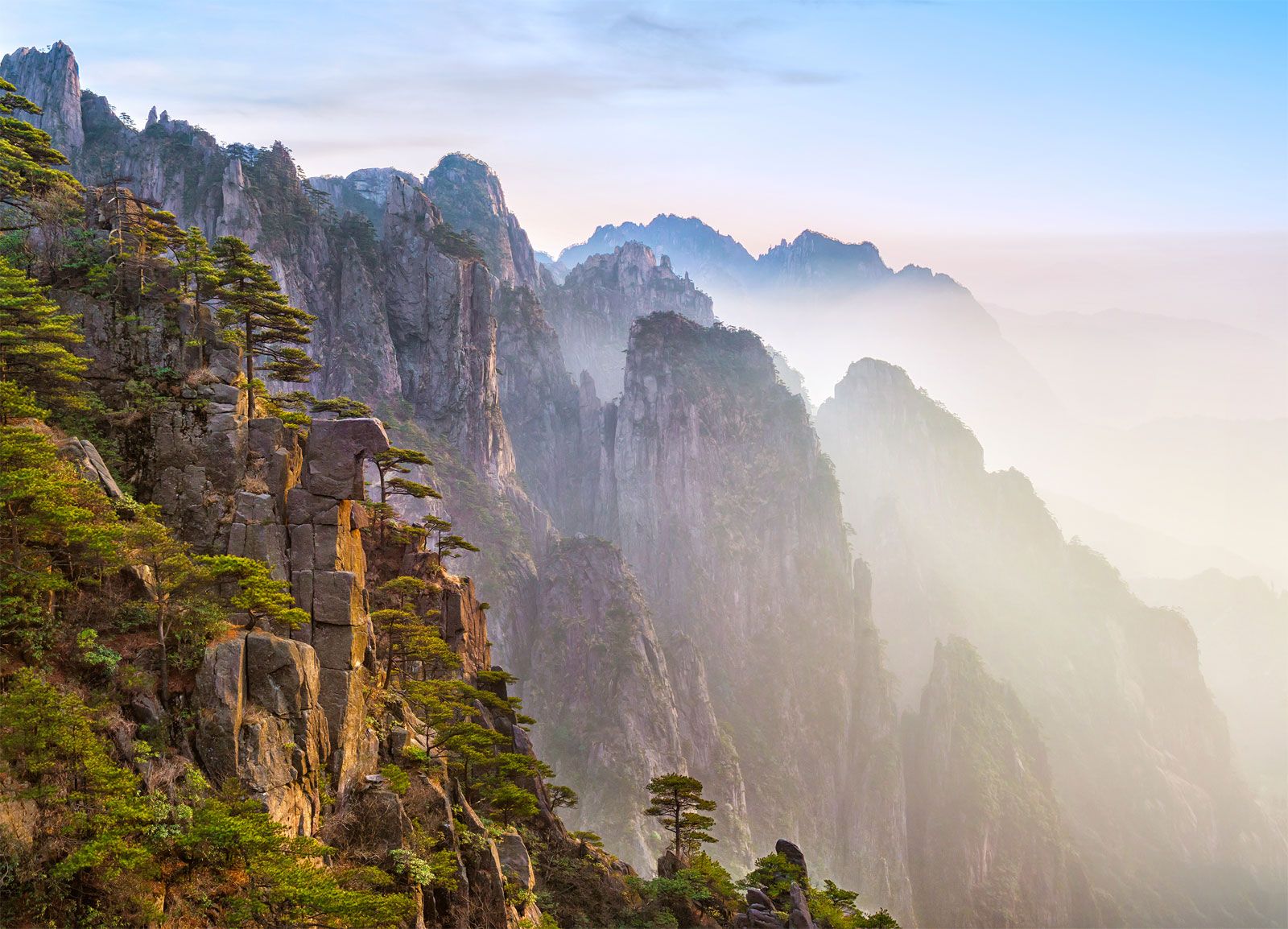
Dabie Mountains.
Main Highlights: What You Absolutely Can’t Miss
The Dabie Mountains, a stunning mountain range at the confluence of Anhui, Henan, and Hubei provinces, offer a treasure trove of experiences for adventurous travelers and nature lovers alike. Here’s a curated list of the must-see highlights that you absolutely cannot miss during your visit.
1. Baima Peak (Baimajian)
Standing tall at 5,830 feet (1,777 meters), Baima Peak is the highest point in the Dabie Mountains and a must-visit for hikers and nature enthusiasts. The peak is often shrouded in mist, creating a mystical atmosphere. The surrounding area boasts lush primitive forests, vibrant wildflowers, and breathtaking views that will leave you in awe. A trek to the summit rewards you with panoramic vistas that stretch across the majestic landscape.
2. Bieshan Lake
As the largest lake in the Baima Peak Scenic Area, Bieshan Lake offers a serene escape. Stretching 1.8 miles (3 kilometers) in length and averaging 1.25 miles (2 kilometers) in width, the lake is perfect for a leisurely boat ride. Choose between an eco-friendly wooden boat for a peaceful glide across the waters or a speedboat for a thrilling adventure. The picturesque backdrop of mountains enhances the experience, making it a photographer’s paradise.
3. Longjing Gorge
Known as “The First Gorge of Dabie Mountains,” Longjing Gorge is renowned for its dramatic waterfalls and stunning rock formations. Four waterfalls, the tallest dropping 230 feet (70 meters), cascade down the cliffs, providing a refreshing spectacle year-round. The gorge’s name translates to “Dragon Well,” inspired by its serpentine shape. Hiking through the gorge not only offers great views but also allows you to feel the power of nature up close.
4. Siwang Fortress
Immerse yourself in history at Siwang Fortress, built in 1860 as a defense against enemy troops. This stone structure, standing 20 feet (6 meters) high, offers a glimpse into the region’s military past. You can walk along the fortress walls and enjoy sweeping views of the Baima Peak Scenic Area. The remnants of observation windows tell the tale of its storied history, making it a fascinating stop for history buffs.
5. Tiantangzhai Scenic Area
Located within the Dabie Mountains, the Tiantangzhai Scenic Area is another highlight offering stunning natural beauty and hiking opportunities. Known for its unique rock formations, lush vegetation, and tranquil environment, this area is ideal for those looking to escape the hustle and bustle of city life. The scenic trails are suitable for all levels of hikers, ensuring everyone can enjoy the breathtaking surroundings.
6. Cultural Significance
The Dabie Mountains are steeped in history as a prominent revolutionary base for the Red Army during the civil war. This historical context adds a layer of depth to your visit. Exploring the region allows you to appreciate not only its natural beauty but also its significant role in China’s history.
7. Local Delicacies and Souvenirs
Don’t miss the opportunity to try local specialties, such as Yellow Sprout Tea, known for its unique flavor and historical ties to royalty. Additionally, seek out Huoshan Ganoderma Lucidum, a revered herbal remedy. These local products offer a taste of the region’s rich culture and traditions.
8. Getting There
The Dabie Mountains are accessible via various means of transport. The nearest airport is Hefei Xinqiao International Airport, and from there, you can take a bus to Huoshan County, followed by a short taxi ride to the scenic areas. If you prefer trains, Lu’an Railway Station is your gateway to the mountains.
Conclusion
The Dabie Mountains offer a blend of natural beauty, adventure, and history that is sure to captivate every traveler. Whether you’re hiking to the peaks, boating on tranquil lakes, or exploring historical sites, this stunning region promises unforgettable memories. Prepare to be enchanted by the majestic landscapes and rich cultural heritage that make the Dabie Mountains a must-visit destination in China.
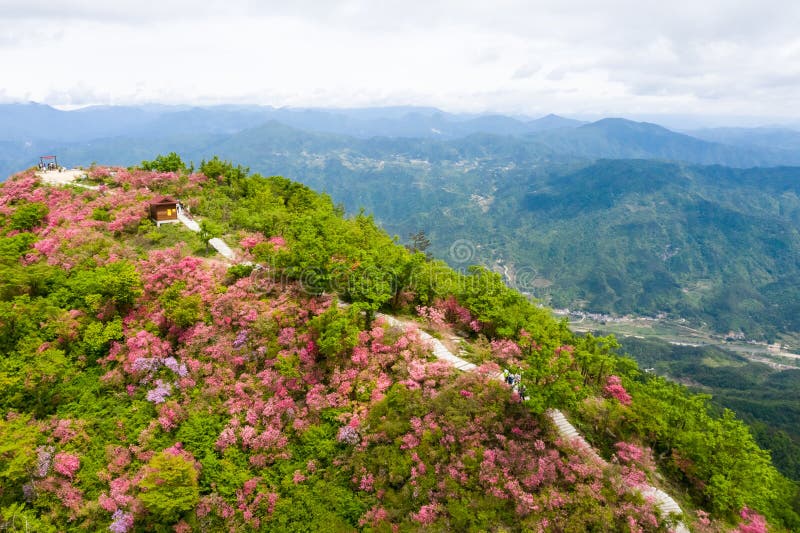
Dabie Mountains.
Planning Your Visit: A Practical Guide
Planning Your Visit: A Practical Guide to the Dabie Mountains
The Dabie Mountains, located at the convergence of Hubei, Henan, and Anhui provinces, offer a stunning natural playground for international travelers. With majestic peaks, lush forests, and rich cultural history, this mountainous region is a hidden gem waiting to be explored. To help you plan your visit, here’s everything you need to know.
Getting There
By Air
The nearest major airport is Hefei Xinqiao International Airport. From the airport, you can take an airport shuttle bus to Hefei West Bus Station. From there, catch a bus to Huoshan County, which takes about three hours and costs around CNY 40. Be sure to check the bus schedules, as the first bus departs at 6:40 AM, and the last one at 6:00 PM.
Once in Huoshan County, take a local bus to Taiyang Village. There are only two buses per day to Taiyang, departing at 7:00 AM and 2:00 PM. The bus ride lasts 2.5 hours and costs CNY 25. You can either rent a car or take a taxi to reach the Baima Peak Scenic Area, which is about 20 minutes away.
By Train
If traveling by train, arrive at Lu’an Railway Station. From there, take a taxi to Lu’an South Bus Station, which will take about an hour. From the bus station, you can catch a bus to Huoshan County and then transfer to a local bus or taxi to the scenic area.
Best Time to Visit
The ideal time to visit the Dabie Mountains is from March to November, when the weather is pleasant, and the natural scenery is in full bloom. Spring is particularly beautiful as wildflowers cover the landscape, while summer provides lush greenery and vibrant wildlife. Winters are cooler, making it a quieter time to explore, but some attractions may have reduced hours.
Admission Fees
Visitors to the Dabie Mountains should be aware of the entrance fees, which vary by season:
- March to November:
- Baima Peak: CNY 110
- Longjing Gorge: CNY 90
- Bieshan Lake: CNY 80 (including boat ticket)
-
Siwang Fortress: CNY 80
-
December to February:
- Baima Peak: CNY 55
- Longjing Gorge: CNY 45
- Bieshan Lake: CNY 40 (including boat ticket)
- Siwang Fortress: CNY 80
Children taller than 1.2 meters require half-price tickets, while those shorter can enter for free.
Opening Hours
The scenic areas are open from 7:00 AM to 4:00 PM year-round. It’s advisable to start your day early to make the most of your visit.
Key Attractions
-
Baima Peak: As the highest peak in the Dabie Mountains at 1,777 meters, Baima Peak is famous for its breathtaking views and a rich variety of flora and fauna. The area is often blanketed in clouds, providing a mystical atmosphere.
-
Longjing Gorge: Known for its stunning waterfalls, this gorge is perfect for those who enjoy hiking and nature photography. The highest waterfall here drops a dramatic 70 meters.
-
Bieshan Lake: The largest lake in the area, Bieshan Lake offers serene boat rides, allowing visitors to soak in the beautiful surroundings while enjoying the tranquility of the water.
-
Siwang Fortress: This historical site offers a glimpse into the region’s past. The fortress, built in 1860, provides panoramic views of the surrounding mountains.
Where to Stay and Eat
Accommodation: There are various lodging options near the scenic area, ranging from cozy guesthouses to hotels. It’s advisable to book in advance, especially during peak season.
Dining: Local eateries serve traditional Anhui cuisine, known for its rich flavors and unique ingredients. Be sure to try local specialties like Yellow Sprout Tea and dishes featuring Huoshan Ganoderma Lucidum, a prized medicinal mushroom.
Tips for Your Visit
- Wear Comfortable Shoes: With plenty of hiking opportunities, sturdy footwear is essential.
- Stay Hydrated: Carry water with you, especially during hikes.
- Respect Nature: Follow local guidelines to preserve the natural beauty of the Dabie Mountains.
- Cultural Sensitivity: Be mindful of local customs and practices, which enrich your experience and foster positive interactions with residents.
With its captivating landscapes and rich history, a trip to the Dabie Mountains promises an unforgettable adventure. Whether you’re an avid hiker or a nature lover, this destination offers something for everyone. Enjoy your journey!
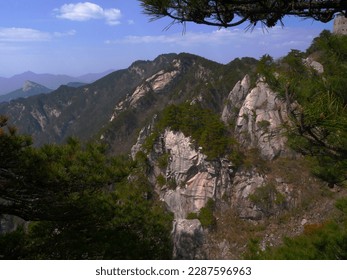
Dabie Mountains.
Tickets: Prices, Booking, and Tips
Visiting the Dabie Mountains, a majestic range that straddles the borders of Anhui, Henan, and Hubei provinces, is a thrilling experience for any traveler. Here’s everything you need to know about tickets, pricing, and tips to ensure a smooth visit.
Ticket Information
Admission Fees:
– March to November:
– Baima Peak: CNY 110
– Longjing Gorge: CNY 90
– Bieshan Lake: CNY 80 (includes boat ticket)
– Siwang Fortress: CNY 80
- December to February:
- Baima Peak: CNY 55
- Longjing Gorge: CNY 45
- Bieshan Lake: CNY 40 (includes boat ticket)
- Siwang Fortress: CNY 80
Discounts:
– Children taller than 3.9 feet (1.2 meters) are eligible for half-price tickets.
– Children under 3.9 feet can enter for free.
Opening Hours
- March to November: 7:00 AM – 4:00 PM
- December to February: 7:00 AM – 4:00 PM
Booking Tips
-
Purchase Tickets in Advance: While tickets can be bought on-site, it’s advisable to book in advance during peak seasons to avoid long lines. Online platforms like Trip.com often provide options for advance booking.
-
Plan Your Visit: A recommended sightseeing time is about 3-4 hours, allowing you to explore the key attractions like Baima Peak, Bieshan Lake, and Longjing Gorge without rushing.
-
Check for Promotions: Keep an eye out for seasonal promotions or package deals that can provide savings on ticket prices or combined entry to multiple attractions.
-
Transportation Coordination: If you’re using public transportation, familiarize yourself with bus and train schedules in advance. The journey to the mountains can require multiple transfers, so planning is key.
-
Local Guides: Consider hiring a local guide for a more enriching experience. They can provide in-depth insights into the history and ecology of the area, enhancing your understanding of this beautiful region.
Getting There
The Dabie Mountains are accessible via various modes of transportation, including buses and taxis from nearby cities. The nearest major airport is Hefei Xinqiao International Airport, from where you can take a shuttle bus to Huoshan County, followed by local transportation to the scenic areas.
Plan your trip to the Dabie Mountains with these tips in mind, and prepare to be captivated by the breathtaking landscapes, rich history, and diverse ecosystems that await you!
How to Get There: A Complete Transportation Guide
To embark on your adventure to the stunning Dabie Mountains, a magnificent mountain range straddling the borders of Anhui, Hubei, and Henan provinces, you’ll need to navigate a few transportation options. This guide will help you plan your journey seamlessly, whether you’re arriving by air, train, or road.
By Air
The nearest major airport to the Dabie Mountains is Hefei Xinqiao International Airport (HFE). Upon landing, you have a couple of options to reach the mountains:
- Airport Shuttle Bus:
- Take Shuttle Bus Line 4 to Hefei West Bus Station. The journey takes about 30 minutes.
-
From Hefei West, catch a bus to Huoshan County. Buses run from 06:40 AM to 06:00 PM and take approximately 3 hours, costing around CNY 40.
-
Taxi or Ride-Sharing:
- For a more direct route, consider hiring a taxi from the airport to Huoshan County, which takes about 2.5 hours and costs roughly CNY 300. If you can share a ride with fellow travelers, this can significantly reduce costs.
Once in Huoshan County, you can continue your journey:
– Bus to Taiyang Village: Buses leave for Taiyang Village at 07:00 AM and 02:00 PM, taking about 2.5 hours for CNY 25.
– Car Rental or Taxi: From Taiyang Village, it’s a short 20-minute drive to the Baima Peak Scenic Area, costing around CNY 30.
By Train
If you prefer to travel by train, head to Lu’an Railway Station, which is the closest major train hub to the Dabie Mountains. Here’s how to proceed:
-
Taxi to Lu’an South Bus Station: After arriving at Lu’an Railway Station, take a taxi to Lu’an South Bus Station (approximately CNY 20, about a 20-minute ride).
-
Bus to Huoshan County: From Lu’an South Bus Station, catch a bus to Huoshan County. The frequency varies, but you can expect to find several buses throughout the day.
-
Local Transport to Scenic Area: Once in Huoshan County, you can either take a local bus or hire a taxi to reach the Baima Peak Scenic Area.
By Road
For those who prefer driving, renting a car is a flexible option. The Dabie Mountains are accessible via well-maintained roads, and driving allows you to explore the scenic beauty at your pace.
- From Hefei: The drive to the Dabie Mountains takes about 3.5 hours. Follow the G36 expressway for a direct route to Huoshan County.
- From Lu’an: The journey from Lu’an to Huoshan is approximately 1.5 hours, making it a convenient starting point.
Local Transportation Options
- Buses: Once you reach Huoshan County, buses are available to various attractions within the Dabie Mountains.
- Taxis: Taxis are readily available and provide a more comfortable option for traveling to specific sites like Baima Peak.
Important Tips
- Language: While major transport hubs might have English signs, it’s helpful to have your destination written in Chinese. The name “Dabie Mountains” in Chinese is 大别山 (Dàbié Shān).
- Cash: Have some cash on hand for bus fares and small purchases, as not all places accept credit cards.
- Timing: Plan your arrival times carefully, especially if relying on buses, as the frequency may vary, particularly during off-peak seasons.
With these transportation options outlined, you’re well-equipped to explore the breathtaking landscapes and rich history of the Dabie Mountains. Enjoy your journey!
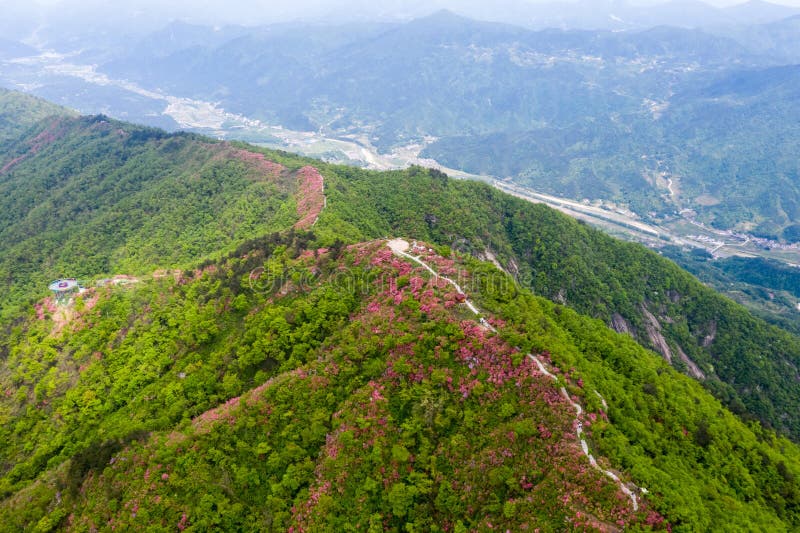
Dabie Mountains.
Local Cuisine and Accommodation Nearby
Nestled in the stunning Dabie Mountains, visitors can savor a delightful array of local cuisine and find comfortable accommodations that enhance their mountain retreat experience.
Culinary Delights
1. Yellow Sprout Tea
One of the must-try specialties of the region is Yellow Sprout Tea, known for its delicate flavor and health benefits. Grown in the high-altitude areas surrounding the mountains, this tea was historically reserved for royalty. Many local tea houses offer tastings, allowing you to experience its unique qualities firsthand.
2. Huoshan Ganoderma Lucidum
Often referred to as the “mushroom of immortality,” this valuable herbal fungus is known for its immune-boosting properties. You can find various dishes incorporating ganoderma lucidum at local restaurants, or even purchase dried versions to take home.
3. Traditional Anhui Cuisine
Don’t miss out on the opportunity to enjoy traditional Anhui dishes. Local restaurants serve up hearty meals that feature ingredients sourced from the surrounding mountains and rivers. Signature dishes include:
– Stewed Bamboo Shoots: A seasonal favorite, often cooked with pork or chicken for a savory flavor.
– Baked Tofu: Crispy on the outside and soft within, this dish is typically accompanied by a spicy dipping sauce.
– Wild Mushroom Stir-fry: A celebration of local produce, this dish highlights the diverse fungi that thrive in the mountains.
Where to Stay
1. Dabie Mountain Resort
This resort offers a perfect blend of comfort and nature, with rooms that provide breathtaking views of the peaks. Enjoy amenities such as a spa, on-site dining featuring local cuisine, and guided tours to explore the natural beauty of the area.
2. Local Guesthouses
For a more authentic experience, consider staying in one of the guesthouses run by local families. These accommodations often provide cozy rooms with traditional decor and home-cooked meals. It’s an excellent way to immerse yourself in the local culture and hospitality.
3. Tiantangzhai Scenic Area Hotels
Located near one of the major peaks, hotels in this area offer easy access to hiking trails and stunning scenery. Many establishments cater to international travelers, ensuring a comfortable stay with modern amenities while still providing a local touch.
Final Thoughts
The Dabie Mountains offer not only breathtaking landscapes but also a rich culinary scene and a range of accommodation options. Whether you’re enjoying a cup of Yellow Sprout Tea while gazing at the peaks or relaxing in a comfortable resort after a day of exploration, the experience is sure to be memorable.

Dabie Mountains.
Frequently Asked Questions
Frequently Asked Questions About the Dabie Mountains
1. What is the best time to visit the Dabie Mountains?
The ideal time to visit the Dabie Mountains is during the spring (March to May) and autumn (September to November) months. During these seasons, the weather is mild, and the natural scenery is at its most vibrant, with blooming flowers in spring and stunning foliage in autumn.
2. How do I get to the Dabie Mountains?
You can reach the Dabie Mountains by air, train, or bus. The nearest airport is Hefei Xinqiao International Airport. From there, you can take an airport shuttle to Huoshan County, followed by a local bus or taxi to the scenic area. Alternatively, you may arrive at Lu’an Railway Station and take a taxi to Huoshan County, where you can catch a bus or taxi to the mountains.
3. Are there any entry fees for the Dabie Mountains?
Yes, there are entry fees for different attractions within the Dabie Mountains. For example, the Baima Peak costs CNY 110 from March to November, and CNY 55 during the winter months. Other attractions like Longjing Gorge and Bieshan Lake also have their respective fees. Discounts are available for children above certain heights.
4. What are the main attractions in the Dabie Mountains?
Key attractions include Baima Peak, Longjing Gorge, Bieshan Lake, and Siwang Fortress. Each of these sites offers unique natural beauty and historical significance, making them must-visit spots when exploring the area.
5. How long should I plan to spend at the Dabie Mountains?
A full day is generally recommended for visiting the Dabie Mountains, with 3-4 hours allocated for sightseeing and hiking. This allows ample time to take in the stunning landscapes and enjoy the various attractions.
6. Is it safe to hike in the Dabie Mountains?
Yes, hiking is generally safe in the Dabie Mountains, but it’s advisable to stick to marked trails and be cautious of the terrain, especially in more rugged areas. Wearing appropriate footwear and carrying enough water is recommended.
7. What should I pack for a trip to the Dabie Mountains?
Pack comfortable hiking shoes, weather-appropriate clothing, a water bottle, sunscreen, and a camera to capture the stunning views. If you plan to visit in spring or autumn, a light jacket may also be necessary, as temperatures can vary.
8. Are there accommodations available near the Dabie Mountains?
Yes, there are several accommodation options near the Dabie Mountains, ranging from hotels to guesthouses. It’s advisable to book in advance, especially during peak tourist seasons, to ensure you secure a comfortable place to stay.
Final Thoughts on Your Trip
As your journey through the majestic Dabie Mountains draws to a close, take a moment to reflect on the breathtaking vistas and rich history that this remarkable region has to offer. From the towering heights of Baima Peak to the serene beauty of Bieshan Lake, each step you took was filled with the whisper of ancient legends and the vibrant pulse of nature.
The Dabie Mountains are not just a destination; they are a profound experience that intertwines the past with the present. The echoes of the Red Army’s storied history resonate through the trails, while the diverse flora and fauna invite you to appreciate the delicate balance of life in this unique watershed. Whether you challenged yourself to climb its rugged trails, reveled in the tranquility of its lakes, or explored the cultural significance of its landmarks, the mountains have surely left an indelible mark on your spirit.
As you prepare to leave this enchanting landscape, carry with you the memories of the stunning panoramas, the thrill of adventure, and the warmth of the local hospitality. Let the beauty of the Dabie Mountains inspire your future travels and remind you of the incredible connections that exist between nature, history, and the human spirit. Until your next adventure, may the essence of Dabie stay with you, igniting your wanderlust for years to come.